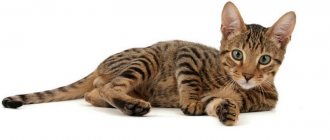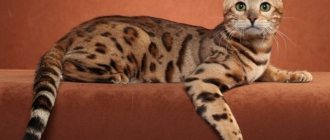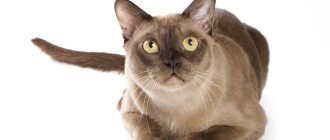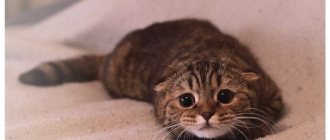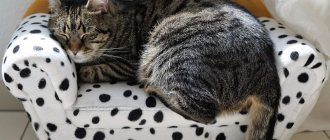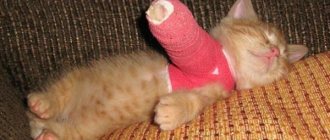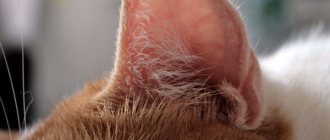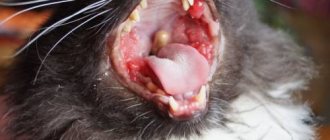How they appeared
The cat tribe appeared on the island after one story. In 327, one ship was wrecked near the island. The mother of Constantine the Great, Helen, traveled on it. In a difficult situation, she asked God to save their ship. In return, Elena promised to found a monastery. The story ended happily. The ship was still able to sail to the nearest shore. This place turned out to be the Akrotiri peninsula.
A few months later, Elena built the monastery of St. Nicholas. It is located 10 km from Limassol. But how are cats connected to this story? The fact is that that time was not very favorable for the population of Cyprus. There was a terrible drought on the island. Because of this disaster, the fauna in Cyprus became extinct, but many snakes grew. Creeping reptiles caused a lot of trouble, and it was necessary to somehow fight them.
INTERESTING TO KNOW: “Cat Dad” Yuri Kuklachev
That's why Elena came up with the idea of filling the island with cats. They were brought in in large numbers, and after some time, they multiplied again. The animals managed to clear Cyprus of snakes in a few years.
Several animals settled in the monastery. Currently, the number of seals living in this place exceeds a hundred. The state allocates funds to feed cats in monasteries, and the nuns also feed them. In addition, tourists who visit the monastery also bring food to the animals.
Tour guides introduce many tourists to this history of the appearance of cats on the island when they visit the monastery of St. Nicholas.
Capital cat house
The four-legged animals have not spared the capital of the island either. Pussies gathered in Nicosia in the park at St. Macarius Hospital. This is a medical facility for children.
No one specially collected the animals in this place; they chose their own shelter. Perhaps the choice of habitat is related to the large number of children in the park. Tourists often come here to watch the purrs walking around.
Cypriots claim that the cats remember frequent visitors to the park and come out to greet them.
Description
Among all the cats in Cyprus, it will be difficult to find individuals that even remotely resemble purebred ones. Basically they are all street and different suits. Cats in Cyprus come in a variety of sizes and colors. There are both individuals with short hair and long hair. But mainly only short-haired animals can be observed. This is partly due to the warm climate on the island.
Most animals in Cyprus are healthy, however, sometimes there are sick animals. Some show signs of “street fighting.” The general mood of street animals and those that inhabit monasteries is quite friendly. They are positive and feel completely safe on the island. Some tourists note that the animals are proud and pathetic. In general, cats have a special relationship with visitors.
Thanks to the fact that tourists often visit the Monastery of St. Nicholas not empty-handed and feed street animals, the cats themselves come out to meet them. Some rush towards people walking, especially if they have a package in their hands. Animals happily rub against their legs, allow themselves to be stroked and photographed.
But it’s better not to pick them up - cats are quite freedom-loving and can severely scratch their skin. The animals have virtually no negative experiences with people. Therefore, if a tourist pets one cat, two more may immediately approach him.
Cat park in Tala
In Cyprus there is another paradise for cats - a park in Tala. Here tourists can admire especially large groups of pussies. The park is located near Paphos, on the territory of the monastery of Agios Neophytos. At first, the animals lived near the parking lot of the Cypriot monastery, but then the monks decided to allocate a separate landscaped area for them. Volunteers were happy to get involved.
Here they accept individuals from the population, having previously sterilized them. Otherwise there will be more cats than people. More than a hundred felines live in the park.
Export ban and population control
Although there are quite a lot of animals on the island, there is a ban on their export. Importing cats to Cyprus is also accompanied by great difficulties. To do this, you need to go through preliminary procedures - collect health certificates, get the appropriate vaccinations, wait in quarantine, etc.
Since there is a ban on export, the number of individuals on the island must be somehow regulated. There are no official statistics that can confirm the number of tailed animals on the island. However, the number of animals is regulated in the following way: when cats become too crowded in a certain area, special services catch them and take them to a monastery or to nurseries.
INTERESTING TO KNOW: How do cats drink water?
Unfortunately, as the animal population increases, sanitary and hygienic problems arise. Because of this, sometimes the local population attempts cruel treatment. For example, there are cases of poisoning of tailed animals. But fortunately, this kind of situation can be called the exception to the rule.
Caring for cats is a long-standing responsibility of the monastery
After a “working” day, the cats returned back to the monastery to get a tasty treat. By the way, the duty of the monks included mandatory care for the lesser brothers. But the cats “should” not forget about their direct responsibilities, for which they were brought to Cyprus. They say that the monastery murks, hearing the church bell of “their” monastery, went hunting as if on command. If the bell rang twice, then they had the right to return home.
Whether this is true or fiction is unknown. But the fact that from generation to generation Cypriot cats passed on the experience of dealing with snakes to their offspring seems to be true. After all, in a fairly short time they exterminated all the poisonous reptiles on the island. And in gratitude from the residents of Cyprus they received the lifelong right to walk wherever they want, to be fed always and everywhere, to go wherever they want, even if it is a monastery or its holy of holies - the Altar.
Where else can you watch
Since there are so many felines in Cyprus, special establishments have been created specifically for their residence. So, you can come and see animals in two large nurseries - Malcolm Cat Protection Society and Tala Monastery Cats.
The first institution was founded by English cat advocates. It is located near the mentioned monastery of St. Nicholas. The number of animals on the territory of the nursery is more than 100 individuals. The facility has special facilities for the comfort of animals - hammocks, swings and beds.
Anyone can visit the nursery and bring treats to the animals. They are allowed to be petted and picked up. On the territory of the nursery there are gazebos for visitors to relax and a toilet room. Admission is free, the nursery is open daily.
Another nursery is more of a kind of cat park. It is more convenient to enter from Paphos. However, you can’t get into the cat’s abode at any time. Thus, the nursery receives visitors for only 4 hours every day - from 10:00 to 14:00. The organization is non-profit and relies on charity. Therefore, anyone can make a small donation to the nursery.
Cyprus cat. Who is she?
Contents hide
Cyprus cat. Who is she?
Friends, those of you who have been on holiday in sunny Cyprus have probably paid attention to the local cats of a bizarre “marbled” color. By the way, this fabulous island is incredibly rich in cats: some animals are kept as pets, others are left to their own devices and live on the street. Some tourists are captivated by the beauty of Cypriot cats and, by hook or by crook, take them to their homeland as a “living” souvenir. The breed is not officially recognized by any felinological organization in the world, but this fact does not affect its popularity in any way. These cats are loved in many countries located far beyond their native island!
Brief history of the breed. Some researchers, based on the results of archaeological excavations, believe that Cypriot cats are one of the oldest cat breeds on the planet, no less than 4000 years old. There are also suggestions that the ancient Egyptians, who visited the island, purchased and took several specimens to Egypt - the characteristics of the Cypriot cat and Egyptian breeds are too similar. The animal is often called the “Cypriot Aphrodite”. In some sources you can read about the close connection between Cypriot cats and the ancient Byzantine monastery of St. Nicholas, where cats have been welcomed since time immemorial. Sometimes the monastery is called “the cat’s monastery.” Today, native Cypriots still adore their cats and value them for their outstanding hunting abilities. And no one really counted how many cats tourists take home.
What does the breed look like? Cats come in several coat lengths, the most famous being the Cypriot Longhair cat. The animals are strong, large, have an impressive and even somewhat “menacing” appearance. Adult cats typically weigh 8-9 kg. Beautiful almond-shaped eyes come in several colors. There are many color options; There are cats of the same, “solid” color, there are cats with a pattern, and tabby color is also common. We cannot mention both the short-haired and semi-long-haired varieties, they are also incredibly beautiful, especially with the characteristic fluffy “collar” on the neck!
Temperament and personality. As we have already noted, Cypriot cats make wonderful pets, affectionate, intelligent and loyal. Cats are incredibly inquisitive and love to be aware of all household chores. We recommend the breed to people who are looking for a kind, affectionate and, most importantly, calm friend and companion. The breed is not very active! Cats literally enjoy the company of their owners and love to follow them everywhere—let’s count these qualities as their asset. We have already mentioned the hunting abilities of the “Cypriots”: cats masterfully deal with rats and mice. Another positive property is that cats will not annoy you with their annoying meows, except sometimes to remind you that it’s time for a snack.
Care and maintenance. So, you need to decide which option is most suitable for you - short-haired or long-haired. In the latter case, the animal sheds heavily and needs to be brushed frequently, ideally visiting a grooming salon from time to time. Cats shed especially heavily in the fall and spring. Naturally, with short-haired cats there is much less hassle.
Health and life expectancy. The breed is distinguished by enviable health - probably, this is due to their “isolated” island history. The cats were not crossed with anyone and no outside experiments were performed on them - the breed developed strictly according to its own laws. It is important to provide your pet with a healthy and balanced diet, taking into account its age characteristics - that’s all. With proper owner care and proper care, a Cyprus cat will live from 12 to 15 years, sometimes a little more.
How to find a breeder? A very difficult task! Before writing the article, we specifically found out: in the UK there are no breeders specializing in this breed. It is difficult to say how things are in other countries. Perhaps on the Internet you can find a club for fans of the breed, where they will tell you how to find a kitten - a descendant of a cat that was once taken from Cyprus by enchanted tourists.
Original publication: What Is A Cyprus Cat? Source and photo:
Bring a souvenir from Cyprus
Many tourists have a slight problem: they want to buy something as a keepsake of the cats that inhabit the island. Souvenir shops in Cyprus satisfy the demand of tourists; they can purchase the following products with the image of a cat:
- bags;
- T-shirts of different sizes;
- souvenir figurines;
- towels;
- magnets;
- mugs.
Manufacturers apply tailed muzzles to textiles, ceramics and other materials. Such products are very popular among tourists.
Reptiles
Cyprus is home to a huge number of species of reptiles: chameleons, geckos, agamas, monitor lizards, lizards and 8 species of snakes, 3 of which are dangerous to humans.
The most poisonous of the Cypriot snakes, the viper , reaches a length of up to 1.8 meters. This snake has a discreet color - grayish or brownish, which allows it to successfully camouflage itself. The viper is found in rocky foothills, gorges with springs, and the ruins of abandoned houses. The snake itself does not attack a person, but can bite if you accidentally step on it or otherwise disturb it. If you are bitten by a viper, you should take a special serum as soon as possible and consult a doctor. Two more species of poisonous snakes in Cyprus are less dangerous to humans. They are called lizard snake (brown with light stripes or olive green with a yellowish belly) and cat snake (gray-beige with dark stripes).
In the mountainous regions of Cyprus you can find the Cypriot snake with a white ring around the eyes, the gradient-colored olive snake, a large snake reaching up to 3 meters in length, grass snakes and other types of snakes that do not pose any danger to humans.
Common Chameleon , a species of lizard that can also be easily seen in Cyprus, is known to be distinguished by its unique ability to change skin color, allowing these animals to “merge” with the surrounding reality. The common chameleon reaches 30 centimeters in length, and its usual skin color is green with dark spots. Chameleons feed on insects, which they catch with the help of a long and tenacious tongue.
Other types of lizards that are very common on the island are geckos and agamas , as well as the so-called snakeheads . Favorite habitats of lizards are the crevices of medieval castles and other historical sites.

